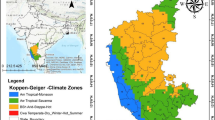Abstract
This paper used five years (2001–2006) time series of MODIS NDVI images with a 1-km spatial resolution to produce a land cover map of Qinghai Province in China. A classification approach for different land cover types with special emphasis on vegetation, especially on sparse vegetation, was developed which synthesized Decision Tree Classification, Supervised Classification and Unsupervised Classification. The spatial distribution and dynamic change of vegetation cover in Qinghai from 2001 to 2006 were analyzed based on the land cover classification map and five grade elevation belts derived from Qinghai DEM. The result shows that vegetation cover in Qinghai in recent five years has been some improved and the area of vegetation was increased from 370,047 km2 in 2001 to 374,576 km2 in 2006. Meanwhile, vegetation cover ratio was increased by 0.63%. Vegetation cover ratio in high mountain belt is the largest (67.92%) among the five grade elevation belts in Qinghai Province. The second largest vegetation cover ratio is in middle mountain belt (61.80%). Next, in the order of the decreasing vegetation cover ratio, the remaining grades are extreme high mountain belt (38.98%), low mountain belt (25.55%) and flat region belt (15.46%). The area of middle density grassland in high mountain belt is the biggest (94,003 km2), and vegetation cover ratio of dense grassland in middle mountain belt is the highest (32.62%), and the in-creased area of dense grassland in high mountain belt is the greatest (1280 km2). In recent five years the conversion from sparse grass to middle density grass in high mountain belt has been the largest vegetation cover variation and the converted area is 15931 km2.
Similar content being viewed by others
References
Austin M P, Smith T M, 1989. A new model for the continuum concept. Vegetation, 83: 35–47.
Chen X Q, Tan Z J, Schwartz M D et al., 2000. Determining the growing season of land vegetation on the basis of plant phenology and satellite data in northern China. International Journal of Biometeorology, 44: 97–101.
Chen Xiongwen, Zhang Xinshi, Li Bailian, 2005. Influence of Tibetan Plateau on vegetation distributions in East Asia: A modeling perspective. Ecological Modelling, 181: 79–86.
Dennison P E, Roberts D A, 2003. The effects of vegetation phenology on endmember selection and species mapping in southern California chaparral. Remote Sensing of Environment, 87: 295–309.
Editorial Board of the Vegetation Atlas of China, Chinese Academy of Sciences, 2001. Vegetation Atlas of China 1:1,000,000. Beijing: Science Press. (in Chinese)
Fang J Y, Chen A P, Peng C H et al., 2001. Changes in forest biomass carbon storage in China between 1949 and 1998. Science, 292: 2320–2322.
Fang Jingyun, Piao Shilong, He Jinsheng et al., 2003. Increasing terrestrial vegetation activity in China, 1982–1999. Science in China (Series C), 33(6): 554–565. (in Chinese).
Gao Zhiqiang, Liu Jiyuan, 2000. The study on driving factors and models of NDVI change based on remote sensing and GIS in China. Climatic and Environmental Research, 5(2): 155–164. (in Chinese)
Grossman Y L, Ustin S L, Jacquemond S et al., 1996. Critique of stepwise linear regression for the extraction of leaf biochemistry information from leaf reflectance data. Remote Sensing of Environment, 56: 182–193.
Hou Xueyu, 1988. Chinese Physical Geography · Phytogeography. Beijing: Science Press. (in Chinese)
Lewis M M, 1998. Numeric classification as an aid to spectral mapping of vegetation communities. Plant Ecology, 136: 133–149.
Li X R, Jia X H, Dong G R, 2006. Influence of desertification on vegetation pattern variations in the cold semi-arid grasslands of Qinghai-Tibet Plateau, Northwest China. Journal of Arid Environments, 64(3): 505–522.
Liu Jiyuan, Zhuang Dafang, Ling Yangrong et al., 1998. Vegetation integrated classification and mapping using remote sensing and GIS technique in Northeast China. Journal of Remote Sensing, 2(4): 285–291. (in Chinese)
Oppelt N, Mauser W, 2004. Hyperspectral monitoring of physiological parameters of wheat during a vegetation period using AVIS data. International Journal of Remote Sensing, 25: 145–159.
Roberts D A, Green R O, Adams J B, 1997. Temporal and spatial patterns in vegetation and atmospheric properties from AVIRIS. Remote Sensing of Environment, 62: 223–240.
Shen Yuancun, Xiang Liping, 2001. The Physical Geography of Qinghai Province. Beijing: China Ocean Press. (in Chinese)
Sun Hongyu, Wang Changyao, Niu Zheng et al., 1998. Analysis of the vegetation cover change and the relation-ship between NDVI and environmental factors by using NOAA time series data. Journal of Remote Sensing, 2(3): 205–210. (in Chinese)
Wang Genxu, Ding Yongjian, Wang Jian et al., 2004. Land ecological changes and evolutional patterns in the source regions of the Yangtze and Yellow rivers in recent 15 years. Acta Geographica Sinica, 59(2): 163–173. (in Chinese)
Wei Yaxing, Wang Liwen, Wang Yimou, 2004. Using TM to monitor the desertification in West China. Bulletin of Soil and Water Conservation, 24(4): 47–50. (in Chinese)
Yang Jianping, Ding Yongjian, Chen Rensheng, 2005. NDVI reflection of alpine vegetation changes in the source regions of the Yangtze and Yellow Rivers. Acta Geographica Sinica, 60(3): 467–478. (in Chinese)
Zhang Baiping, Wu Hongzhi et al., 2006. Integration of data on Chinese mountains into a digital altitudinal belts system. Mountain Research and Development, 26(2): 163–171.
Zhang Jun, Ge Jianping, Guo Qingxi, 2001. The relation between the change of NDVI of the main vegetational types and the climatic factors in the northeast of China. Acta Ecologica Sinica, 21(4): 523–524. (in Chinese)
Zheng Jingyun, Ge Quansheng, Hao Zhixin, 2002. Climate change impacts on plant phenological changes in China in recent 40 years. Chinese Science Bulletin, 47(20): 1582–1587. (in Chinese)
Author information
Authors and Affiliations
Corresponding author
Additional information
Foundation: China’s Special Funds for Major State Basic Research Project, No.2007CB714406; Knowledge Innovation Program of the Chinese Academy of Sciences, No.KZCX2-YW-313; Foundation of the Chinese State Key Laboratory of Remote Sensing Science, No.KQ060006
Author: Wang Liwen (1971–), Ph.D Candidate, specialized in remote sensing applications.
Rights and permissions
About this article
Cite this article
Wang, L., Wei, Y. & Niu, Z. Spatial and temporal variations of vegetation in Qinghai Province based on satellite data. J. Geogr. Sci. 18, 73–84 (2008). https://doi.org/10.1007/s11442-008-0073-x
Received:
Accepted:
Published:
Issue Date:
DOI: https://doi.org/10.1007/s11442-008-0073-x




